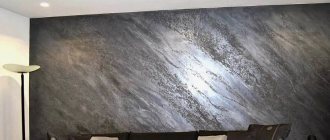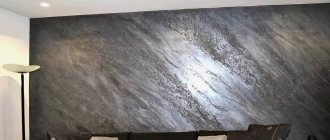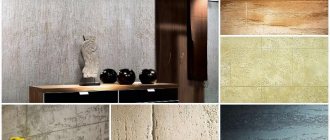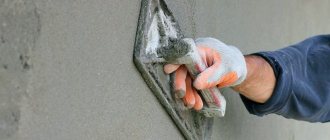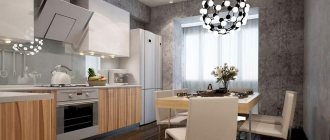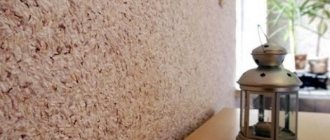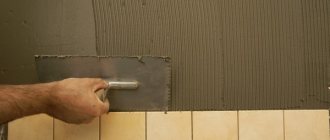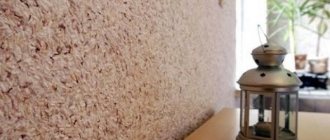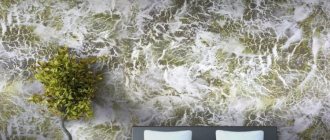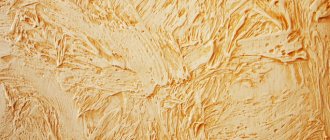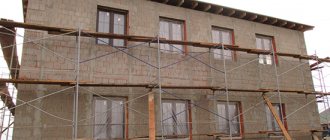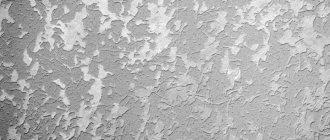Types of decorative plaster
In total, the finishing materials market includes over a dozen types of decorative plaster. Each option differs in composition, color content, viscosity, ductility, elasticity during application, texture, processing time, and storage. Some mixtures are perfect for finishing the facades of houses, others - for finishing interior spaces.
Marble plaster with silver plating Source ural-resurs.su
Decorative plaster with mother of pearl Source decorstudia.com.ua
Silk
Plaster to which mother-of-pearl is added looks like silk-screen printing on the wall. Texture here is achieved by adding small grains of stone chips or cellulose fibers. Silk plaster has earned high marks for decorativeness due to the delicate tints of the finished coating. Glare appears depending on the viewing angle where natural or artificial light falls. Silk plaster is ideal for the living room, bedroom, library, study, any room where there is a lot of upholstered furniture.
Decorative silk plaster in the living room Source zen.yandex.ru
Bark beetle
Some interior styles harmoniously accept surfaces with an imitation of artificial aging or a protective layer spoiled by a bark beetle. For these purposes, it is appropriate to use decorative plaster in the interior with its interesting name - bark beetle. Such finishes give the style concept greater authenticity, originality and antiquity. The basic basis of this technology is a granular mixture.
Decorative plaster - chaotic bark beetle Source drive2.ru
Mosaic
The appearance of single-color walls with small specks is mosaic decorative plaster. There are mixtures with different particle sizes and different colors. It is used to decorate walls both outside buildings, houses, and indoors. The surfaces are smooth and easy to clean. They are resistant to chips, scratches, and impacts from heavy objects. This plaster fits perfectly on almost any surface - concrete, brick, standard plaster, plasterboard panel material. Another plus is good ventilation.
Decorative mosaic plaster in a children's room Source mirplaster.by
Art concrete
Art concrete is a modern finishing material for walls, ceilings and floors. The mixture contains dry cement and gypsum powder. Various additives, fillers, dyes, and varnishes are also added to them. Soft plasters allow you to create original imitations of a concrete surface. They are decorated with rivets, pipes (especially in the loft style), images of slabs, stacked blocks (ideal for high-tech or minimalism styles).
Decorative plaster coating art-concrete in the interior of a bedroom in a minimalist style Source design-homes.ru
Bark beetle
In order to achieve such a texture. Almost any decorative plaster will do, the main thing is that it contains granules of different sizes; they give that same recognizable effect. The effect resembles old wood that has already been eaten by wood-boring beetles. In our latitudes, this texture is often used for external decoration of facades, but it is also used during interior work, it’s just that fine-grained decorative plaster is used here. During work, the master can choose the location of the grooves; they can be circular, vertical or horizontal, it all depends on the previously chosen design. The peculiarity is that this texture will fit perfectly into any interior design, the main thing is to give it the right shade.
Varieties by composition
Wall finishing material fillers have different features, functional and technical properties. If this is an option for decorating surfaces with gypsum or lime, then you can safely count on their strength. Such mixtures are usually used to finish the ceiling between beams in interior styles: Provence, country, chalet, vintage, retro, loft. Or when plastering sections of walls to look antique.
Decorative plaster in eco-style living room interior Source behance.net
Additional additives for decoration, creating an unusual coating:
- metallized threads;
- crushed shells;
- large cellulose fibers;
- pigments and colors.
Any decorative marble plaster in the living room, dining room, or hallway will not only beautifully recreate a beautiful pearlescent-shiny surface, but will also reliably protect the walls from various aggressive external factors. Neither mechanical damage, nor chemicals or detergents will damage the integrity of the coating. A number of other types of additives to plaster have the same or different properties.
Glossy marble plaster on the walls of the living room Source odnastroyka.ru
Silicone
These types of plaster appeared on the market relatively recently and are new. Like everything new, the material has unique properties and capabilities, but its price is quite high. This material is excellent for interior wall decoration. Among the main advantages are:
- High safety margin.
- Resistant to wet environments.
- Does not fade even after many years.
- Clings tightly to the surface.
- Very easy to care for..
- Nothing prevents air masses from circulating.
These types of plaster are also supplied ready-made; before application, errors during mixing are eliminated, because no preparation is required. The process of applying plaster itself is quite simple and takes a little time. But at the same time, this decorative plaster should be applied to the surface after priming. The primer should be purchased from the same manufacturer that created the plaster itself, which increases the final cost of the work.
Combination of decorative plaster with finishing
If you need to determine what types of finishes decorative plaster can be combined with in the bedroom, then you need to pay attention to the texture, color and pattern of the surface. Finishing refers to different coverings of walls, their projections, columns, niches, as well as details of the decoration of the ceiling, window or interior arched openings.
Textured decorative wall decoration harmoniously combines with smooth wallpaper Source kordecor.ru
If the room is being furnished in a loft style, then a structural mixture or art-concrete plaster will work well with brick or stone masonry. For living rooms in a classic, English or Italian style, a combination of smooth surfaces of ordinary plaster, painted in the same tone, with marble decorative plaster would be ideal.
Marble decorative plaster serves as an ideal background for artistic decoration in the form of fish Source delaisteny.ru
Any authentic or ethnic style will look harmonious if you combine decorative bark beetle plaster with wooden surfaces - ceiling beams, curtain rods, shelves, furniture.
Decorative bark beetle plaster fits perfectly into the interior with wooden doors, panels, ceilings and furniture Source homedezen.com
Venetian plaster looks accentuated with a plain ceiling (painted or stretched). Artistic parquet or beautiful tiles are ideal for this exquisite wall covering.
Light Venetian plaster on the walls harmonizes well with the parquet floor and white ceiling Source parketluxe.ru
Marseille wax is most suitable for interiors in Provence, Baroque, and Country styles. It completely replaces the wallpaper functions. This type of wall decoration will harmonize wonderfully with gypsum stucco molding and elegant forging elements.
Artistic stucco on Marseilles wax plaster Source vatikam.com
Mosaic plaster, granite (or any composite finishing material), stone, brickwork is an ideal solution for combining two different finishing methods. The granite slab also has inclusions in the mosaic, so they go well together.
Mosaic plaster in combination with white painted wooden panels Source vplate.ru
Sea Breeze plaster has a palette of over 45 color options. Among them, the most popular ones are sandy, golden, sea green, pearl, light and dark mother-of-pearl, white gold, silver, chameleon. This allows the material to be used in tandem with decorative wallpaper, photo wallpaper, airbrushing and other types of plasters.
Decorating the wall with sea breeze decorative plaster combines harmoniously with parquet. Source oboitop.com.ua
Silicate
This decorative plaster contains a binding element in the form of liquid potassium glass, which makes it the most durable of all varieties. But at the same time, this type of coating is not safe for health, so it is not used when performing interior decoration, only for finishing the facade. Among the advantages, we can highlight the fact that the plaster lasts for more than 20 years, does not accumulate dirt and easily tolerates a humid environment.
Main types of plaster textures:
- Venetian.
- Bark beetle
- Structural.
- Sea breeze.
- Marseille wax.
How to properly apply decorative plaster with your own hands
There are several additional types of decorative plaster application:
- fur coat;
- "lamb";
- terrazite;
- foam.
All of them are done using special tools and hand movements. You can work with both granular and fibrous mixtures. Grinding machines, textured rollers, comb spatulas, and textured sponges are used.
The decorative effect of bark beetle plaster varies. It depends on the direction of the working movement of the plasterer’s hand. The application of vertical bark beetles is done with sharp movements in a vertical straight line. Horizontal - horizontally (a trajectory in waves is allowed). Chaotic - application in a circular motion.
Important! The thickness of the layer should be the same as the thickness of the solid granules. Using a grater, they “scratch” the surface. This is how bark beetles are produced.
The principle of sgraffito plaster consists of several steps. First, a layer of the color that makes up the design itself or the background surrounding the design is applied. Allow the layer to dry and settle. Then a second layer of a contrasting color is applied. Here you can no longer wait for complete drying. You need to have time to cut the necessary contours to get the drawing.
Working with the second layer of decorative plaster sgraffiti Source mvestnik.ru
You can make the right craquelure by applying acrylic paint of the same color to the wall surface. Let everything dry thoroughly. Then a special mass is distributed over the painted surface. There are options for compositions that crack on their own after drying. The remaining plasters are heated with an industrial hair dryer. Cracks will form in heating areas. This method is needed when you need to achieve cracks only in some places.
Clear crack lines craquelure Source remont-book.com
Anyone can treat indoor walls with mosaic plaster. If, for example, sgraffito requires the skills of a master, then the mosaic mixture can simply be applied using a regular spatula and a metal grater.
Applying decorative mosaic plaster with a metal float Source kraski-net.ru
Before application, be sure to level the wall and then treat it with a primer. Sea Breeze should be applied correctly by spreading the topcoat over the wall. It is allowed to dry, and then decorative plaster is spread over the painted surface. It is better to repeat the pattern in increments of 1 square. At the end, let everything dry for 24 hours. Only after 2 weeks can the coating be washed with a damp cloth or sponge.
Perfectly applied sea breeze decorative plaster with the addition of silvering Source art—deco.com
Venetian
Once Venetian plaster is applied to the surface, it creates a smooth and uniform wall. Often this texture is used as an imitation of marble. The effect is almost the same, but the cost of finishing work is significantly reduced. To achieve this result, Venetian plaster is applied in several layers, this can be 2-10 layers. The basis for this material is concrete. Which has gone through the priming stage, but it can also be wood or even metal. The final finishing stage is coating the surface with wax. This is a complex job that can only be performed by an experienced craftsman; independent attempts will not lead to the desired result.
Sands
This group of materials is called “sands”, since they contain real natural quartz sand or synthetic fiberglass of different granulations, and are based on a mother-of-pearl or deep-matt component. The choice of these materials is also very diverse: with the effect of sandy winds, sea waves, clouds with a 3D illusion.
It is important that the service life of “sand” plaster is more than ten years. At the same time, the texture and brightness of colors are preserved in their original form. This is a good solution for high-traffic areas, for example, in corridors.
Price:
from 462 rubles per square meter.
Sea breeze
A popular texture that appeared on the market relatively recently. Fine-grained sand and pearlescent dust are added to the plaster, which creates pleasant shimmers on the surface. Craftsmen use traditional tools, but at the same time they can create absolutely any visual effect on the surface. In most cases, the customer gives preference to waves, dunes, and shading. This effect can be achieved using a roller, sponges, film, and various tools with teeth. The work is quite complex and requires artistic inclination on the part of the master, so it is almost impossible to independently implement such projects.
Tips for beginners
If you decide to plaster the walls yourself with textured mixtures, I suggest you listen to the advice of professionals:
If you do not have experience working with this material, choose simple types of plaster; you can apply relief designs using stencil rollers. They can be bought at any construction market.
Unusual living room design in purple
- In plaster bark beetles, use special granules in your work. Move them in the desired direction with spatulas.
- To create bas-reliefs, stucco moldings, and three-dimensional decorative figures, use gypsum compositions, provided that you can do this. Otherwise, you can buy ready-made ones. There are plenty of them in hardware stores too.
- If up to this point you have no experience and have never worked with decorative plaster, try your strengths and capabilities on an inconspicuous section of the wall of a balcony, loggia or toilet.
In dark, neutral colors
Consider the features of your walls. Textured plaster fits well and without problems on surfaces made of brick or concrete without prior preparation.
- Consider the climate conditions of the room. For example, you can buy any type of covering for the living room, corridor or bedroom. And in the bathroom or kitchen, where the climatic conditions are unstable, pay attention to silicate mixtures. By the way, they can be periodically updated and repainted.
- When choosing colors in your bedroom, consider the space. If it is located in the north, use coffee shades, beige, orange, burgundy or pink. If it is sunny, then it is preferable to use cold colors: green, gray, blue.
Cozy corner for relaxation
Structural
This is any textured plaster with small granules or fibers. After finishing the work, you get an uneven and always original surface that fits into any interior design. The master can use special tools, rollers or even sponges to give the walls the desired texture. In some cases, craftsmen can use straight grinders, which can speed up the process and achieve a more original result. Such surfaces are often given a gray tint or gold tones are preferred.
Color of personal choice and style
Accentuation is the most famous and most important design technique that always plays a win-win game. Especially then, the task is not only to refresh the room, but also to make it stylish, fashionable, and add a touch of sophistication and wealth. The choice of colors here comes second to the choice of material. Color is the mood, emotions and impressions that a person receives from the renovation.
The choice of color affects mood, emotions and impressions
It should be in harmony with the style, not irritate, not tire. The fundamental choice of color palette is based on four groups:
- Fresh. They give transparency, purity and spirituality.
- Warm. They calm loved ones, and add coziness to the room, making them ready to relax.
- Saturated. They have a high percentage of coloring matter.
- Calm. Soft colors, most often with shades of gray. This decision brings balance and peace to the home.
The color should be in harmony with the style, not irritate, not tire
APPLICATION AREA
1.1. This technological map applies to finishing the surfaces of external wall panels and parts of building facades with fine-grained materials by spraying on an adhesive base in a factory environment.
1.2. Decorative finishing is a coating consisting of fine-grained decorative material, fixed to the surface using adhesives.
1.3. The color of the coating is achieved by using the decorative properties of natural and artificial crushed materials, as well as the color of the adhesive base.
1.4. When linking the technological map to the conditions of a specific reinforced concrete concrete shop /KPD/, the location of the finishing station, calculation of labor costs, and mechanization means are specified, taking into account the maximum use of the mechanisms available at the plant.
1.5. Based on the map data, technological documentation is developed and executed for the manufacture of products finished with fine-grained materials on a specific production line.
